INDIAN ARMED FORCES CHIEFS ON OUR RELENTLESS AND FOCUSED PUBLISHING EFFORTS

The insightful articles, inspiring narrations and analytical perspectives presented by the Editorial Team, establish an alluring connect with the reader. My compliments and best wishes to SP Guide Publications.

"Over the past 60 years, the growth of SP Guide Publications has mirrored the rising stature of Indian Navy. Its well-researched and informative magazines on Defence and Aerospace sector have served to shape an educated opinion of our military personnel, policy makers and the public alike. I wish SP's Publication team continued success, fair winds and following seas in all future endeavour!"

Since, its inception in 1964, SP Guide Publications has consistently demonstrated commitment to high-quality journalism in the aerospace and defence sectors, earning a well-deserved reputation as Asia's largest media house in this domain. I wish SP Guide Publications continued success in its pursuit of excellence.
Exploring new Horizons
NASA’s New Horizons mission has been successful in flagging a major landmark in human history
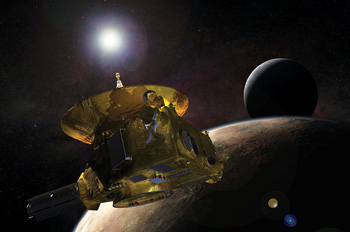
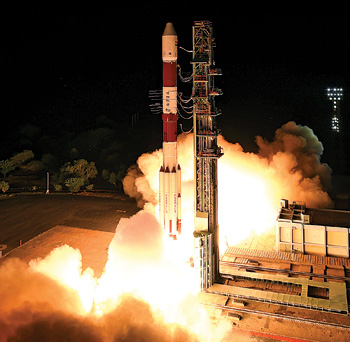
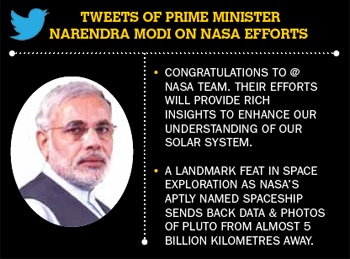
International endeavour at space exploration had suffered a serious setback in the last three months on account of two failures in a row of resupply missions to the International Space Station (ISS). The first to go was the Progress 59 M-27M unmanned space freighter launched by the Russian Federal Space Agency, also known as Roscomos. Launched on April 28, 2015, from the cosmodrome at Baikonur in Kazakhstan, the space vehicle carrying more than three tonnes of critical supplies for the astronauts on board the ISS, suffered a debilitating malfunction, ended up in the wrong orbit and failed to dock. Nowhere to go, the cargo carrying space vehicle along with the vitally needed supplies re-entered the Earth’s atmosphere, broke up over the Pacific-Ocean and was lost. Two months later, another resupply mission to the ISS failed when the Falcon 9 rocket carrying the Dragon cargo space vehicle exploded a few minutes after lift-off from Cape Canaveral in the US. However, the crew aboard the ISS as also all the stakeholders in the regime of space exploration heaved a sigh of relief when Progress 60 docked successfully with the ISS on the morning of July 5, 2015. This ended the nagging uncertainty about the fate of the crew on board the ISS.
Heading for Pluto
The period of uncertainty with resupply missions to the ISS that had cast a gloom over efforts at space exploration has now mercifully been overshadowed by some spectacular successes in space exploration in the recent past. On July 14, 2015, at around 1700 hours Indian Standard Time, the New Horizons mission that had been launched by NASA in 2006, made history of sorts in the regime of space exploration when it flew past the mysterious planet Pluto having travelled more than 4.8 billion km at a speed of 45,000 km per hour. The point nearest to Pluto that the NASA’s New Horizons space vehicle traversed was 12,500 km away. The New Horizons spacecraft is the first space vehicle launched from the Earth to have come anywhere near Pluto. Apart from the seven sophisticated science instruments on board, in honour of Clyde Tombaugh, the astronomer from the United States who discovered Pluto in 1930, the spacecraft was also carrying an ounce of his ashes. Clyde Tombaugh had passed away in 1997.
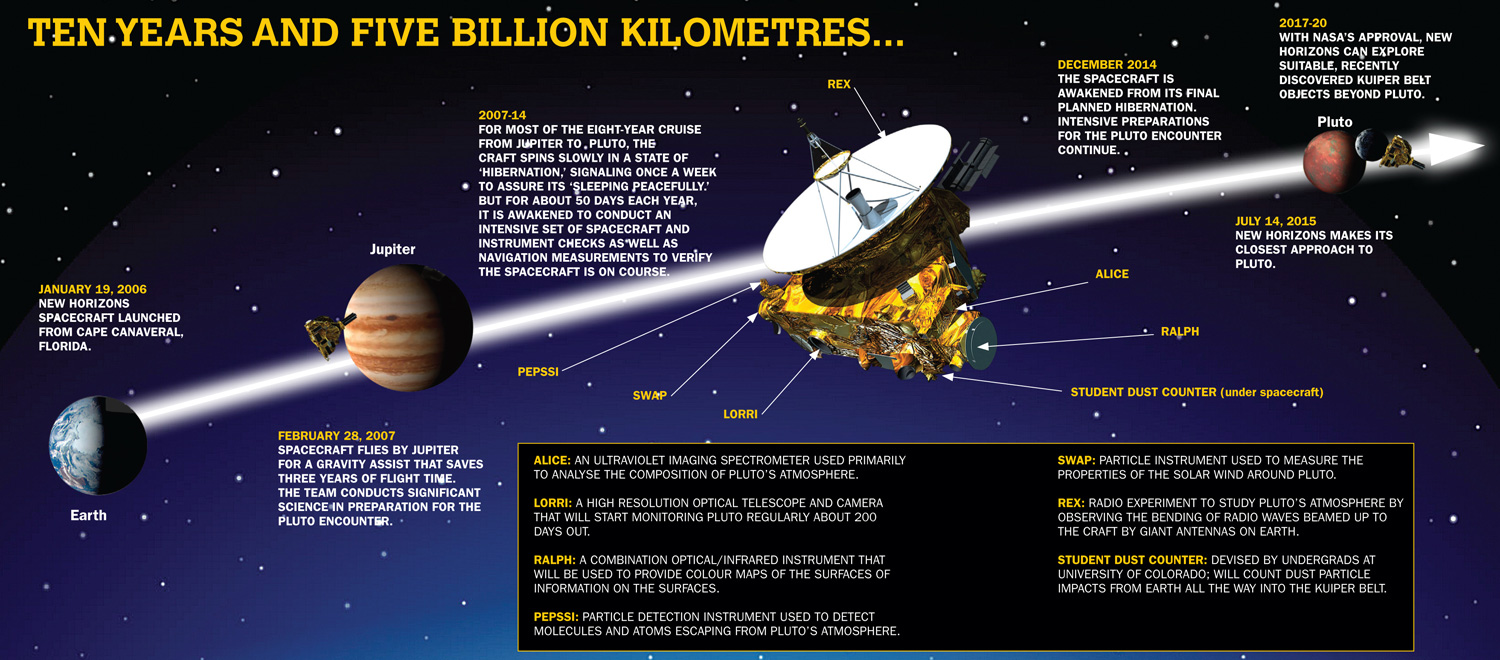
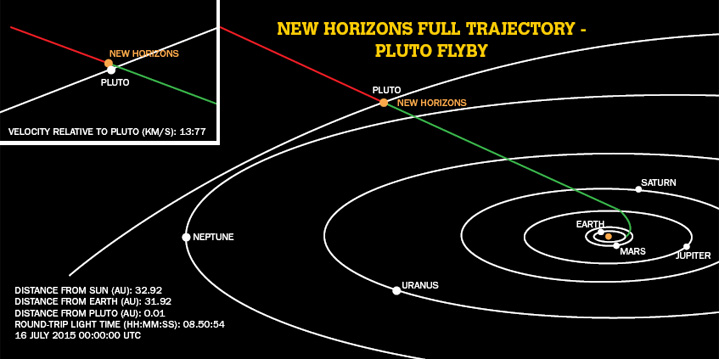
At the time of its discovery in 1930, Pluto was the smallest planet known and was thought to be the ninth planet in the Solar System. The newly discovered planet was named as Pluto by a girl from England who was only 11 years of age. Later two other planets, i.e. Chiron and Eris were discovered. These were larger than Pluto and of the two, in size, Eris exceeded Pluto by 27 per cent. On August 24, 2006, the International Astronomical Union (IAU) coined the definition of a planet for the first time. On account of this definition, the status of Pluto was officially downgraded from a ‘planet’ to that of a ‘dwarf planet’ along with Eris and Ceres. A dwarf planet orbits the Sun just like other planets, but it is smaller, in fact so small that it cannot clear other objects out of its path. However, the scientific community remains divided on the status of Pluto even to this day. As on date, apart from Pluto, the IAU has categorised four other heavenly bodies orbiting the Sun as dwarf planets. These are Ceres, Humea, Makemake and Eris.
Pluto is at a distance of more than 5.92 billion kilometres from the Sun which is equal to 40 times the distance between the Earth and the Sun. Its orbit around the Sun is oval in shape like a racetrack. Pluto is located in a region called the Kuiper Belt which is characterised by the presence of thousands of small, icy objects that are a part of the huge band of planetary debris released during the formation of the solar system some 4.5 billion years ago.
The dwarf planet has three moons, Charon, Nix and Hydra. Charon is the largest of the three and is approximately half the size of Pluto. In size, Pluto is only 2,250 kilometres in width and is slightly smaller than Earth’s moon. The dwarf planet Pluto is about 20 per cent of the weight of the Moon and is about 33 per cent of its volume. Pluto takes 248 years to complete one orbit around the Sun and one day on Pluto is equal to six-and-a-half days on the Earth.
As Pluto has a small mass and is located at a staggering distance from the Earth, it presented daunting challenges for the scientific community and hence did not figure high on the list of heavenly bodies to be explored. A proposed mission in the last decade of the 20th century was called off for a variety of reasons that included unaffordable cost, technical issues and lack of will and determination on the part of the agencies involved. The plan to explore the dwarf planet Pluto was revived in 2003 and funding for a new mission dubbed as ‘New Horizons’ was sanctioned by the US Government. The New Horizons mission was launched successfully on January 19, 2006.
A Close Encounter
One of the biggest concerns for the scientists associated with the Pluto mission was the possibility of collision of the New Horizon spacecraft with debris in the Kuiper Belt that consists of rock and ice. The possibility of such an occurrence was estimated by scientists as being one in 10,000. Receipt of signal from the New Horizons spacecraft on the morning of July 15, 2015, was a confirmation that the space vehicle was flying past the dwarf planet unscathed. The unmanned New Horizons spacecraft had thus successfully completed the nine-year-long expedition in which it had traversed nearly 6 billion kilometres to arrive in the proximity of Pluto. The New Horizons spacecraft thereafter began to beam pictures of the surface of the dwarf planet that represented the very first close look of Pluto by the human race. The images sent by the New Horizons spacecraft have a resoludtion that are ten times that of all the imagery received during other missions in the past. The images will also help scientists explore and unravel some of the mystery of the Kuiper Belt.
From the snapshots received from the New Horizons spacecraft the scientists have estimated that the surface of the dwarf planet in its equatorial region has mountainous terrain covered with ice. The scientists believe that it is indicative of the presence of water. This is an important discovery as water is an essential prerequisite for the presence of life. Scientists also confirmed the existence of a polar ice cap on Pluto as well as the presence of nitrogen in its atmosphere. Peaks in the mountainous region are observed to be rising up to 11,000 ft. Scientists estimate that these mountains are about 100 million years old. An unexpected discovery has been that there is absence of craters on the surface of the dwarf planet. As per John Spencer, the Deputy Leader of the New Horizons mission, relatively speaking, Pluto is a young planet in comparison with the solar system which is 4.56 billion years old. The absence of craters on the surface of Pluto supports the hypothesis about the age of the dwarf planet.
Data received from the New Horizons spacecraft’s sensors reveal the dwarf planet to be 2,370 kilometres across, which is slightly larger than estimates made earlier on based on which the planet was downgraded from planet status to a dwarf planet.
NASA’s New Horizons mission has been successful in flagging a major landmark in human history. Said Alan Stern, Principal Investigator of the New Horizons mission, “Nothing like this has been done in a quarter century and nothing like this is planned by any space agency ever again!” This mission also makes the United States the first nation to send a space probe to every planet from the size of Mercury to Pluto.
Back Home: ISRO Forges Ahead
While the New Horizons space vehicle was hurtling in deep space headed towards Pluto, the Indian Space Research Organisation (ISRO) flagged another milestone in its glorious history. On July 10, 2015, in its 30th launch and carrying the heaviest payload so far, polar satellite launch vehicle (PSLV) C28 carrying five British satellites was launched successfully from the space station at Sriharikota on east coast of India. Three of these satellites are Earth observations satellites while the other two are technology demonstrators. The satellites were inserted into their respective orbits in precisely 19 minutes, an operation carried out with unparalleled clinical precision!
ISRO’s PSLV was designed and developed in the early 1990s at Vikram Sarabhai Space Centre near Thiruvananthapuram in Kerala and was first launched on September 20, 1993. With each subsequent version, the PSLV has undergone upgrade in capability especially in respect of thrust, efficiency as well as weight.
In the last over two decades of service, the PSLV has to its credit 29 successful missions. The PSLV has had an impeccable record of performance and is now regarded as one of the most reliable launch vehicles in the world. Apart from indigenously produced satellites, the PSLV has been used to launch satellites for foreign nations as well on a fairly regular basis. To date, the PSLV has inserted into orbit as many as 40 satellites from 19 countries. Besides the mission to the Moon, the Chandrayaan, in November 2013, the PSLV was used to launch the Mars Orbiter Mission, the Mangalyaan. The fact that ISRO executed the Mission to Mars successfully in the very first attempt, was a rare feat and a genuine feather in its cap.
Enthused by the most recent success, ISRO has plans on the anvil a series of launches, including GSLV-Mark II next month and three more navigational satellites before March 2016. As per Kiran Kumar, Chairman, “ISRO has 28 satellites belonging to six to seven countries to be launched in next three years or so. The next launch scheduled in August 2015 is of GSLV-Mark-II. The satellite has already reached Sriharikota and is going through final tests”. While ISRO is hoping to launch the first SAARC Satellite by the end of next year, the next real challenge for the organisation is manned flight into space!





